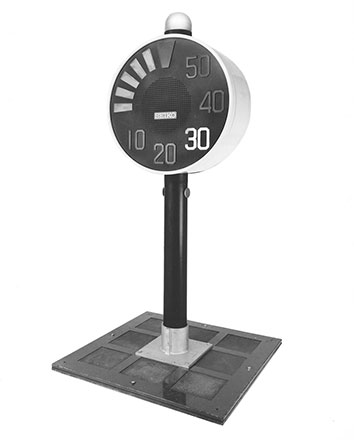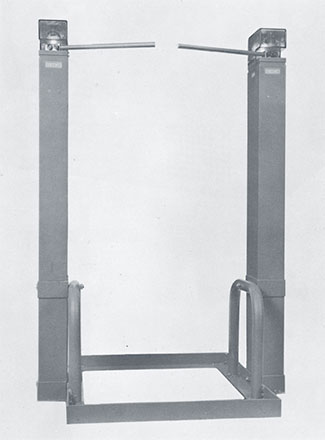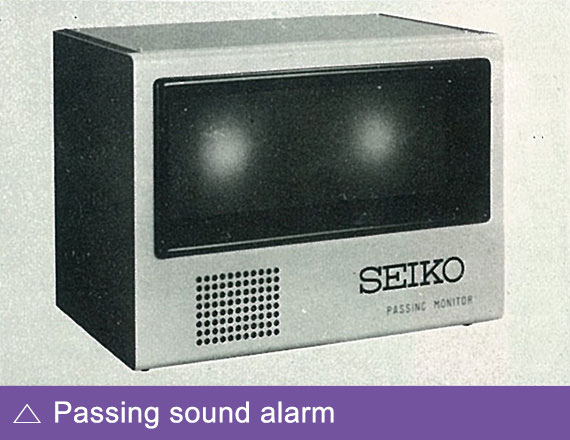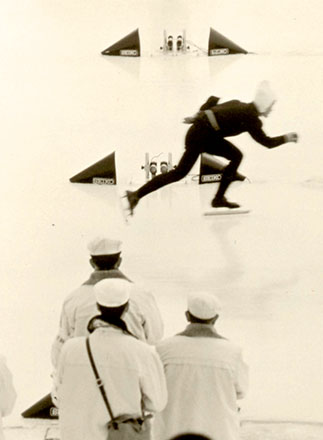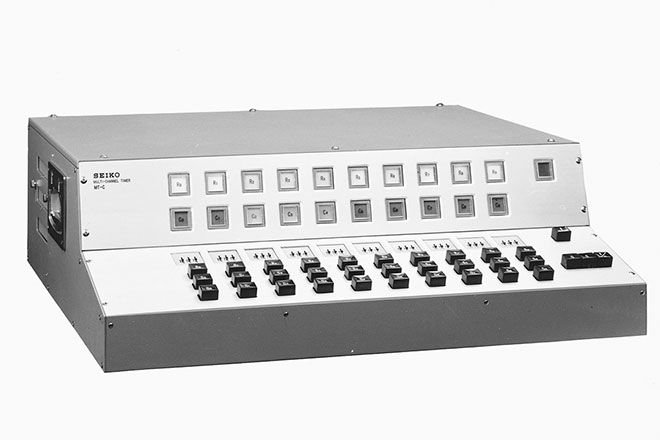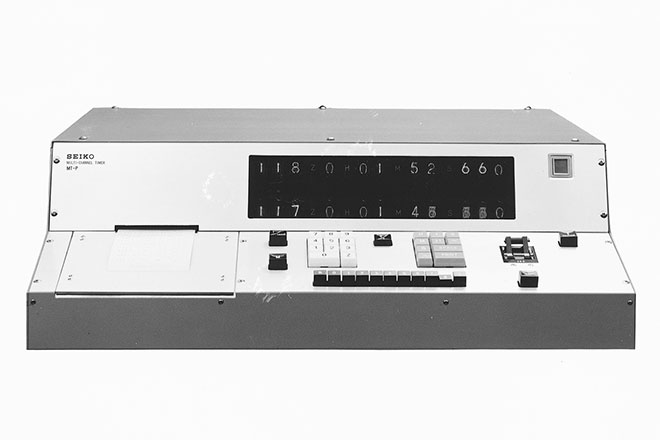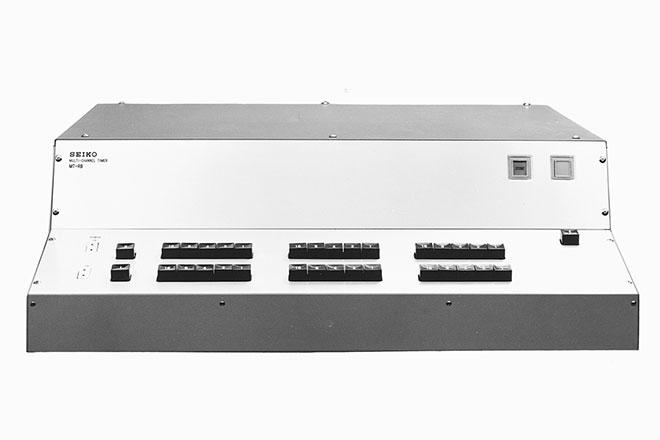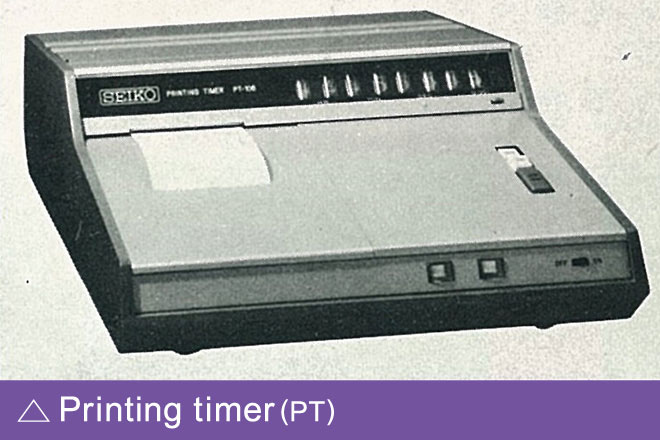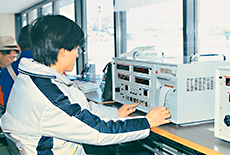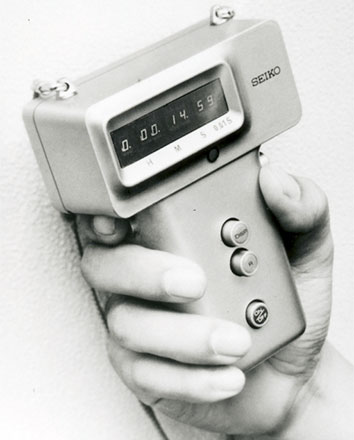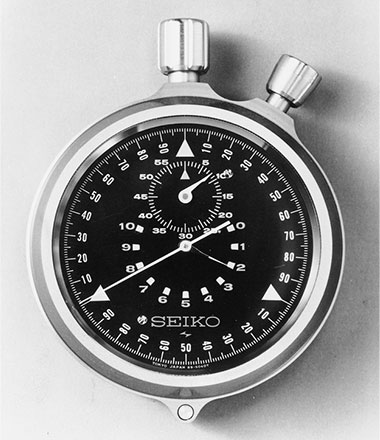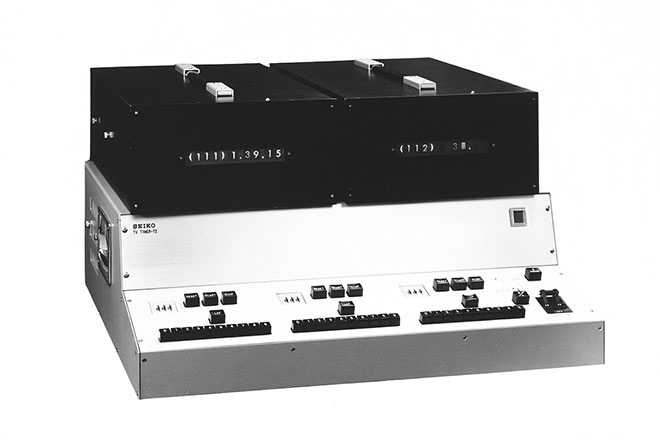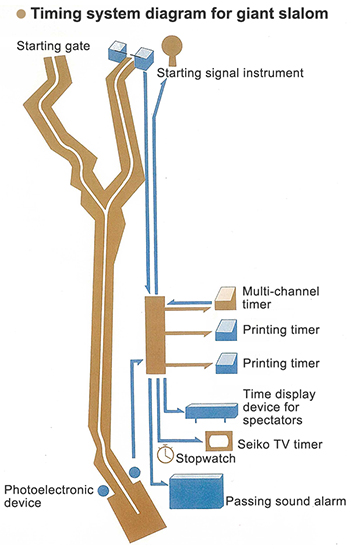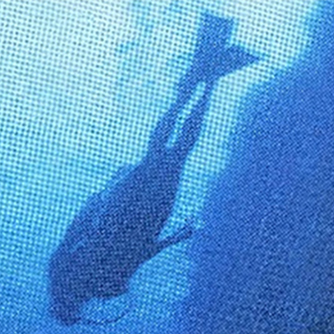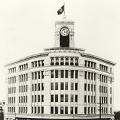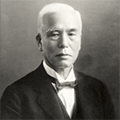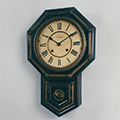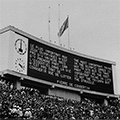Official Timer Seiko
Seiko has served as the official timer for sports competitions of many kinds both at home and overseas since the 18th Olympic Games in 1964 in Tokyo.
An official timer is required to meet specific needs of the events being timed. Beyond the base functions for precise timing, the timer must provide accurate information to news media in real time and deliver clear and legible displays for TV viewers and athletes and spectators at the venues. Seiko has built a system to process total measurements and publish results online to fulfill its duty to “measure time quickly and accurately and convey the results in the clearest possible manner.” Drawing from its rich experience, Seiko has established one of the world’s greatest comprehensive sports timing systems.
Major international competitions that Seiko served as the official timer
Olympic Games
| A.D. | Game title |
|---|---|
| 1964 | Tokyo Olympic Games |
| 1972 | Sapporo Olympic Games (Winter) |
| 1992 | Barcelona Olympic Games |
| 1994 | Lillehammer Olympic Games (Winter) |
| 1998 | Nagano Olympic Games |
| 2002 | Salt Lake City Olympic Games (Winter) |
Other major international games
| 西暦 | Game title |
|---|---|
| 1966 | Asian Games (Bangkok) |
| 1967 | Summer Universiade (Tokyo) |
| 1970 | Asian Games (Bangkok) |
| 1974 | Commonwealth Games (Christchurch) Asian Games (Tehran) |
| 1978 | Asian Games (Bangkok) |
| 1979 | FINA Swimming World Cup (Tokyo) |
| 1982 | Asian Games (New Delhi) |
| 1985 | Summer Universiade (Kobe) |
| 1986 | Asian Winter Games (Sapporo) |
| 1987 | IAAF World Championships in Athletics (Rome) |
| 1990 | Commonwealth Games (Auckland) Asian Winter Games (Sapporo) |
| 1991 | Universiade Winter Games (Sapporo) IAAF World Championships in Athletics (Tokyo) |
| 1993 | Alpine World Ski Championships (Shizukuishi) IAAF World Championships in Athletics (Stuttgart) |
| 1994 | Asian games (Hiroshima) Commonwealth Games (Victoria) |
| 1995 | IAAF World Championships in Athletics (Gothenburg) Summer Universiade (Fukuoka) |
| 1997 | IAAF World Championships in Athletics (Athens) |
| 1999 | IAAF World Championships in Athletics (Sevilla) |
| 2001 | FINA Swimming World Cup (Fukuoka) IAAF World Championships in Athletics (Edmonton) |
| 2002 | Pan Pacific Swimming Championships (Yokohama) ISU World Cup Speed Skating (Nagano) |
| 2003 | Tokyo Marathon (1981) IAAF World Championships in Athletics (Paris) |
| 2004 | ISU World Cup Speed Skating (Nagano) |
| 2005 | IAAF World Championships in Athletics (Helsinki) |
| 2007 | International Swim Meet 2007 in Japan (Chiba) IAAF World Championships in Athletics (Osaka) |
| 2009 | IAAF World Championships in Athletics (Berlin) |
| 2010 | World Sprint Speed Skating Championships (Obihiro) |
| 2011 | IAAF World Championships in Athletics (Tegu) |
| 2013 | IAAF World Championships in Athletics (Moscow) |
Seiko was given the privilege to time a winter Olympic Games for the first time in Sapporo in 1972. Live images of athletes performing at the games in a snowy world were transmitted to people around the world by television broadcast. Seiko arranged a secure system by preparing a minimum of two electric timing systems and an additional two manual timing systems to accomplish its important mission as the official timer. It succeeded “without troubles” at a winter Olympic Games assignment.
Accumulated Preparation and Experience
Seiko started timing skiing and skating in the year following the Tokyo Olympic Games. This posed a significant challenge, as most of the instruments used at the Tokyo Olympic Games functioned poorly under cold winter conditions. The instruments made before Sapporo’s selection as the Winter Olympics venue were not specialized for individual events.
Many winter sports are timed races such as Alpine skiing, speed skating, bobsleigh, and the luge. Unlike track events or swimming, in which the athletes start together, a timed race is measured for every competitor separately. The final placing, therefore, can only be determined after the last competitor reaches the goal. If the timing for any single athlete is faulty or omitted, the whole event is invalid. The official timer is also required to measure time at a precision of 1/100th or 1/1000th of a second for most events under severe natural conditions such as snow, ice, and wind. Timekeeping for winter sports is mostly done under a totally different environment from athletics and swimming in summer games. In winter events, the timing for the start or finish line is often invisible.
Seiko was selected as the official timer for the Sapporo Olympic Games in 1967, five years in advance of the actual events. This gave it the opportunity to develop a new electric timing system for winter events and add a series of improvements to downsize and lighten the equipment, fortify the equipment’s resistance against cold, and so on. Seiko supported 32 winter sports competitions in Japan as an official timer in the five years leading up to the Sapporo Olympic Games commenced on February 3, 1972.
26 models / 583 timing devices, and timing support team
Twenty-six different timing device models (583 devices in total) were used for the 6 sports encompassing 35 events at the Sapporo Olympic Games. The total cable length connecting the timing devices reached 100 kilometers.
The digital electronic timers newly designed for the Games had distinctive features. The development of quartz stopwatches had been underway since the Tokyo Olympic Games, but the digital stop clocks at the time incorporated displays composed of 62 light bulbs arranged in 7 lines because proper display materials were yet to develop. . A luminescent diode became available a few years after the Games, but the batteries were still large. Too big to qualify as a stopwatch, the clock was called a digital electronic timer. The timer allowed the timekeeper to measure time in winter competitions at -20 ℃ and in summer competitions at temperatures over 40 ℃.
Two quartz oscillators with different properties incorporated in the timer could be switched according to the temperature.
Manual timing with mechanical clocks had been completely supplanted by electric timing with quartz clocks before those Olympic Games. The key to successful timing was to overcome mechanical troubles and other problems likely to arise in cold weather conditions severe enough to affect electronic functions. Seiko dispatched a “SEIKO TIMING TEAM” of over 90 staff members to support the games.
Main Timing Devices
-
STORY 01
Starting signal instrument I model (skiing, Biathlon)
-
An instrument used to start athletes at exact 30-second or 1-minute intervals.
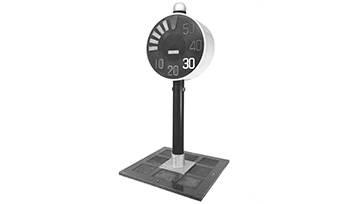
Starting signal instrument I model 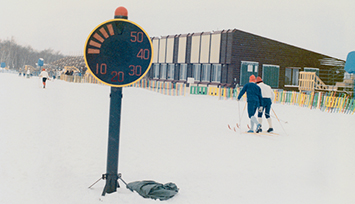
Starting signal instrument I model 2
-
STORY 02
Starting gate (skiing, Biathlon)
-
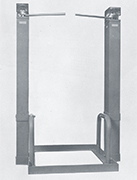
Starting gate A device to output an electric signal at the instant an athlete leaves the gate. The signal is transmitted to a timing device located at the goal point.
The device activates both a multi-channel timer and printing timer.
-
STORY 03
Passing sound alarm (skiing, bobsleigh, luge)
-
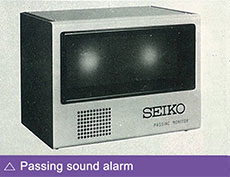
Passing sound alarm This device issues a signal to a manual timekeeper as an instruction to start a stopwatch or digital electronic timer in a precise manner. The device is installed at the goal point and emits light and sound when the athlete passes the starting line. The manual timekeeper starts the stopwatch in response to the signal.
-
STORY 04
Photoelectric beam device (skiing, biathlon, bobsleigh, luge, speed skating, ski jumping)
-
This device emits a photoelectric beam from a projector to a receiver. The receiver transmits a signal to a multi-channel timer and printing timer when an athlete crosses the beam.
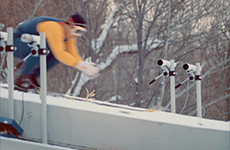
Photoelectric beam device 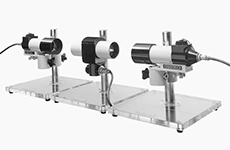
Passing sound alarm for speed akating 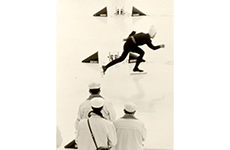
Passing sound alarm for speed akating
-
STORY 05
Multi-channel timer (skiing, bobsleigh, luge)
-
A device to automatically measure and print the time from the start to the goal and send information directly to a time display device. It receives starting and goal signals and measures time by setting the athlete’s number on the counter section in advance. It measures time in 1/1000-second digits and prints out the times rounded half up (or down) to 1/100-second digits. At the same time, the athlete’s number and timing information are sent to the time display device / TV timer.
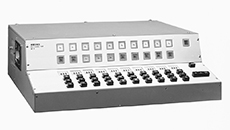
Multi-channel timer 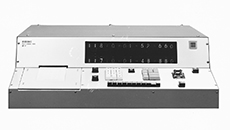
Multi-channel timer 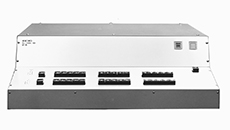
Multi-channel timer
-
STORY 06
Printing timer (skiing, biathlon, luge, ski jumping)
-
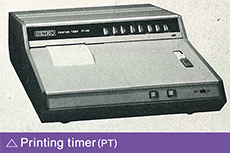
Printing timer An electronic recording device with a time measurement mechanism and printing mechanism combined. It can measure time to an accuracy of 5/10000-second digits and print out the time in 1/1000-second digits. The device is compact, lightweight, and made with cold-resistant electronic parts and materials suitable for winter competitions.
-
STORY 07
Printing timer for speed skating
-
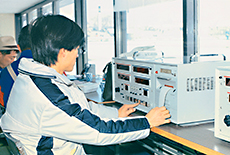
Printing timer for speed skating This timer has a mechanism to measure time in 1/1000-second digits and automatically print it out in 1/100-second digits. It further sends information directly to the scoreboard display device and TV timer.
The timer starts recording an athlete’s time by receiving a signal when the starting pistol fires. It prints out the integral time of the outside and inside courses from the athlete’s start respectively, the net lap time of the current lap, and the number of laps skated (registered when the speed skater crosses the photoelectric device located at the lap point). It displays the data on the scoreboard time display device and TV timer. When the athletes reache a goal, it prints out the goal times and the finishing order.
-
STORY 08
Digital electronic timer
-
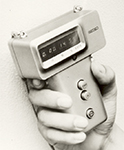
Digital electronic timer This is a handy stopwatch capable of measuring time up to 1/100-second digits using an IC and quartz oscillator vibrating 204,800 times per second. The start, lap, and stop functions are all operated by a pushbutton system. It can measure the integral time after measuring the lap time. The measurement range goes up to 9 hours, 59 minutes, 59 seconds, 99/100ths of a second. It can be incorporated in an electric timing system by linking with a starting pistol, grip switch, photoelectric device, or other devices. It was used for the winter games for the first time, as it could operate in a wide temperature range (from -20 ℃ to +85 ℃) and was waterproofed by a die-cast aluminum case.
-
STORY 09
Stopwatches (1/5th second with split second hand, 1/10th second with split second hand and 1/100th second mechanical stopwatches)
-
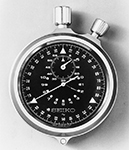
Stopwatches (1/100th second mechanical stopwatches) These are mechanical stopwatches developed for the winter games. They are made with aluminum alloy and have less than half the weight of conventional stopwatches. Their dials are marked with well-considered scales, numbers, and color tones for optimal legibility. The outside is coated in a special Teflon material to prevent ice from sticking on. They boast excellent cold resistance.
Mechanical stopwatches were also used for timing, just in case the electronic timers failed. The stopwatches were remarkably improved over those used at the Tokyo Olympic Games.
-
STORY 10
Seiko TV timer
-
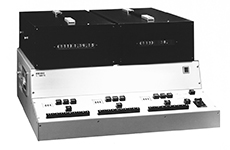
Seiko TV timer Times measured with all sorts of devices are sent to this device and digitally displayed on a screen in numbers. A TV camera films the screen and shows it as the official times on the TV broadcast.
Time measurement method (Alpine skiing)
Electric timing system
1. The athlete starts at a starting sign.
2. A signal is transmitted when the starting gate opens. The multi-channel timer starts measurement and the starting time is simultaneously printed on the printing timer.
3. When the athlete crosses the photoelectric device, the goal time is printed on the printing timer and the multi-channel timer stops measuring.
4. The multi-channel timer transmits data to the TV timer and the electric scoreboard.
The time information is sent to TV viewers and spectators at the venue.
Manual timing system (This is also for backup)
1. The passing alarm at the goal point emits a sound and light when the athlete pushes open the starting gate.
2. The manual timekeeper starts the digital electronic timer or stopwatch based on the passing sound alarm.
3. The manual timekeeper visually confirms that the athlete has reached the goal and stops the digital electronic timer or stopwatch.
References
・『Sapporo Olympic Games and SEIKO』 (K. Hattori & Co., SEIKO NEWS Editorial Section, 1971)
・『SEIKO』, 『DAINI SEIKO』, 『SUWA SEIKO』 (house journals issued in 1972)
・『International Timepiece Journal Vol.36 No.419』(International Timepiece Press, 1995)
・『International Timepiece Journal Vol.37 No.432』 “Visionary Stopwatch – a mechanical stopwatch for the Sapporo Olympic Games that was never commercialized: Taro Tanaka” (International Timepiece Press, 1996)
・『SEIKO’s Timing System for Winter Sports 1971』 (K. Hattori & Co.)


